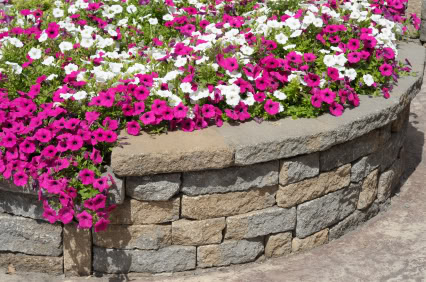Concrete Retaining Walls

Concrete is an excellent material for retaining walls. Concrete retaining walls add stability to areas prone to erosion, preventing soil and rock from sliding. They may also serve an ornamental purpose, hiding unsightly areas or supporting a pretty rock garden. When concrete retaining walls are backfilled, usable square footage can be created.
Other Retaining Wall Materials
Retaining walls don't have to be made of concrete: These barriers can be made of brick, stone, steel, treated wood or railroad ties and are an attractive solution for landscaping challenges. Railroad ties are less common now than in the past due to environmental concerns about the chemicals used to treat the wood, but concrete retaining walls have become more popular since they have less environmental impact than chemically treated products.
Concrete Styles
Concrete retaining walls don’t have to look like concrete. Just as designs can be stamped into concrete for driveways and patios, forms are available that make the poured concrete look like stone or rock. Additionally, eco-friendly stains can transform concrete retaining walls into attractive, architectural features.
Concrete Blocks
Concrete retaining walls can be made of blocks, too. The building blocks are available in a wide variety of textures, shapes and colors and are no longer limited to the familiar flat gray blocks of yore. Granite, brick and limestone are just a few of the textures available. Shapes are limited only by the imagination of the manufacturer. Common shapes include brick, stone, long flat rectangles for borders and more.
Tongue-and-Groove Design
An added benefit of some of the block products is the new tongue-and-groove design. The tongue-and-groove feature makes constructing concrete retaining walls much easier; plus, it adds stability to the structure. As a result, the barrier can be taller than a traditional, unreinforced concrete retaining wall.
Whether to solve an erosion problem or create an architecturally appealing terrace, adding concrete retaining walls to a sloped area can create livable space.
Stability
Determine the depth of the frost line in your area and dig a trench at least 18 to 24 inches below ground level to prevent upheaval. If you or your contractor is using blocks, be sure to dig a trench twice as wide as the stones or bricks. Line the trench with gravel and, for added stability, pour a layer of level concrete.
Among the many options available for concrete retaining walls, whether poured or block, the choices are limited only by budget. A concrete retaining wall can be as beautiful as it is functional. Discuss the possibilities with a professional concrete contractor.
Updated July 29, 2018.
Looking for a Pro? Call us (866) 441-6648

Concrete Average Costs
Concrete Contractors Experiences

Concrete Repair That Was Literally The Answer To My Prayers

Rotted Fence Repair Taken Care Of Fast And Efficiently



